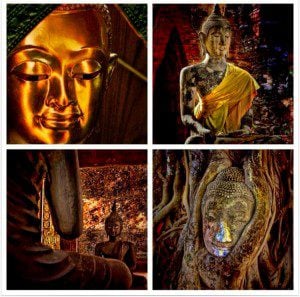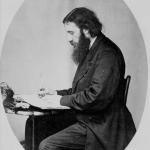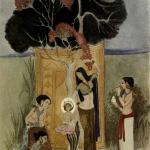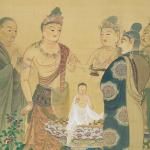 Note: This is the third part of five, based talks from last year’s Rohatsu that students (Brian, Ryan, Erik, and Vera-Ellen – thank you!) transcribed and I edited. The others will be posted here over the next couple weeks. Click here for the first part: “The Root of Zen.” And here for the second: “Sitting Through it All.”
Note: This is the third part of five, based talks from last year’s Rohatsu that students (Brian, Ryan, Erik, and Vera-Ellen – thank you!) transcribed and I edited. The others will be posted here over the next couple weeks. Click here for the first part: “The Root of Zen.” And here for the second: “Sitting Through it All.”
“If you want to understand, if you want an intimate understanding of enlightenment, you should get rid of ‘you’ and ‘Buddha’ and quickly understand this matter of ‘I’. ‘I’ is the great earth and all things, all beings as ‘and’. ‘And’ is not ‘I’ as the old fellow Shakyamuni Buddha. Examine carefully. Deliberate carefully. And clarify this ‘I’ and ‘and.’ If you clarify the meaning of ‘I,’ but fail to clarify ‘and’ you lose the discerning eye.” – Keizan, Record of Transmitting the Light
In the teaching on the six realms of existence (hell, hungry ghost, animial, human fighting god, and god realms), each realm is depicted with a bodhisattva in it. For the human realm the bodhisattva appears as Shakyamuni carrying a pilgrim’s staff.
In ancient times, in China in the 9th and 10th Centuries, the good ol’ days of Zen, tens of thousands of people were out on pilgrimage, on the road, seeking for the truth. These pilgrims commemorated Shakyamuni Buddha’s enlightenment with body and mind, really putting it on the line, really sticking their necks out.
“Commemorate,” etymologically, means to all together relate. So to all together let’s relate to what the Buddha did, sitting under the bodhi tree. It’s really necessary that we, too, put our bodies there. And stick our necks out.
One such pilgrim in the 9th Century was a monk named Yunmen. He later became known as a living Buddha, starting one of the branching streams of the Zen school in China. While he was on pilgrimage, he visited a monk named Muzhou. Muzhou had been a student of the great master Huangbo. When Muzhou was serving Huangbo, he grabbed the shave-pate Linchi and dragged him into the dokusan line. Linchi had been lingering in Huangbo’s community for three years without raising a question. Muzhou had the eye to see that Linchi was somebody with possibility, and he also had the eye to see somebody who was holding back. Muzhou encouraged Linchi to go and meet Huangbo.
When Linchi come forward and ask, “What is the essence of the buddhadharma?” Huangbo hit and chased him out of the room, setting up Linchi’s great enlightenment and spawning another of the main streams of Zen, this one flowing on until today.
Later on this monk, Muzhou, left the religious life to support his aging mother by making sandals, some of which he would kindly leave by the road for pilgrims. Because his tutelage under Huangbo was well known among truth seeking pilgrims, many monks and nuns sought him out. They’d go and knock at his door Muzhou would answer by just cracking the door a little bit, and say “Who is it!?”
Due to his clear eye, he could see through a practitioner immediately. Usually he would slam the door shut, ending the meeting, often before the truth seekers, who had walked in straw sandals for hundreds of miles, had even said a word. And yet they kept coming.
Yunmen was one of these seekers who had Muzhou’s door slammed in his face. But that didn’t stop him. Yunmen returned again and again. One day when Muzhou asked, “Who is it!?” Yunmen said, “It’s me,” and stuck his leg into the doorway. Muzhou slammed the door anyway, reportedly breaking Yunmen’s leg.
Muzhou then said, “Why do you keep coming back?”
Yunmen said, “I’m not clear about the self.”
Muzhou said, “Stone drills from the Qin period.”
It seems that the Qin emperor, an ancient emperor in China, conceived a megalomaniac plan to build a huge palace for which they would need huge granite pillars. They were on their way to completing the drills to dig out the granite for the palace, when the regime fell.
“Stone drills from the Qin period” is usually translated something to the effect of “Utterly useless stuff,” but it’s not just utterly worthless stuff. It refers to an artifact of a megalomaniac scheme. That’s what this self is.
In Keizan’s text, Record of Transmitting the Light, he invites us to have an intimate, immediate understanding of enlightenment, getting rid of this self and Buddha.
Buddha Shakyamuni was known for many things, including being the great renunciate – getting rid of many things. He left home, leapt over the palace walls in the dead of the night and shaved off his hair, practiced austerities for six years. He left his beautiful wife and young son, as well as his father the king. He abandoned a career trajectory as a prince and king himself.
And we too, as we sit, tranquil and upright – there may well be something we have to let go of, something we have to renounce. We could start with renouncing stone drills from the Qin period. The artifacts, the ways of relating that we carry around with us, dragging them on our backs. They’re just yesterday’s dream. To really merge with what is, to become one with mu, for example, get clear about what is it that you have to let go of. What stance, what identity? What stone drill from the Qin period has to be renounced?
Keizan exhorts us to get rid of you and even Buddha and quickly understand this matter of “I.”
What? He tells us to get rid of “you” but understand the matter of I?
This “you” is where we separate ourselves from the environment, from each other and even separate ourself from ourself. Let go of “you” as a subject, or you as an object, the you that you contemplate. Quickly, immediately, intimately, become this matter of “I.” There can’t be procrastinating. It’s done immediately, intimately.
And what about this matter of “I?” Keizan says, “‘I’ is the great earth and all beings as ‘and’.”
This refers back to “I together with all beings and the great earth attain the way.” This “I,” as in “I together,” what is this “I?”
It’s the key to our practice. “I together with all beings.” This little word “and” is the great connector.
Quickly, without separation, understand this matter of “I.” “I is the great earth and all living beings as ‘and.’”
Nothing apart. Instead of chasing after the ten thousand things, the world turns around and the ten thousand things advance.
Then just to make sure we get the point, Keizan says again, “’And’ is not ‘I’ as the old fellow Shakyamuni Buddha.”
In a sense, it is impersonal. The “you” that is the object of awareness seems so personal. Any kind of separation whatsoever – drop them! “Carefully examine, deliberate carefully and clarify this ‘I’ and ‘and’.”
I suspect here that the translation might lead us into thinking that the practice is in the head, swirling. No, it’s just upright sitting and looking very intimately with and through the whole body.
“Even if you clarify the meaning of ‘I,’ but fail to clarify ‘and,’ you lose the discerning ‘I.’”
There’s a suggestion here that this first opening, the first opening of clarity about ‘I,’ isn’t enough. The insight doesn’t yet have legs. There can be clarity about the self, but that clarity is not yet functional in daily life. That doesn’t mean that the insight isn’t important, even vital, in this practice. It just means that these kinds of provisional insights are just the beginning, not the end. And the insight itself can become a stone drill from the Qin period. And so, ongoing training after realization, is essential.
On our pilgrimage together, we’re entering this wonderful middle period of sesshin. This is a really important time to throw ourselves completely into it without any expectation of gain or result. Just doing like the Buddha did. Our energy is changing constantly. We are just change and we are all going through changes. When you become familiar with sesshin, you can see some patterns. There’s no guarantee, but there are some patterns.
Often in this middle period of sesshin, we can really let go and be who we are. The “I,” the host, can sit calmly inside the house and we can just be “and.” We can just be the connection. The heart opens and we hear the raindrops reverberating all around the house, together with the soft hum of the traffic. Just be the sound of the raindrops, the hum of the refrigerator.
One of the dangers of this period, is that we can become complacent, and lull our time away. Dropping a question into the quiet is very important. With muji, “What is mu?” With earnest vivid sitting, the question is just the naked, raw question mark. With the breath, the question is “What is the breath?”
Don’t go to sleep. You’ve come too far in the pilgrimage of your life. You’ve come too far to go to sleep now and lull out with some little realization, some little sense of comfort and ease. Renounce the stone drills from the Qin period and continue practicing timelessly.











